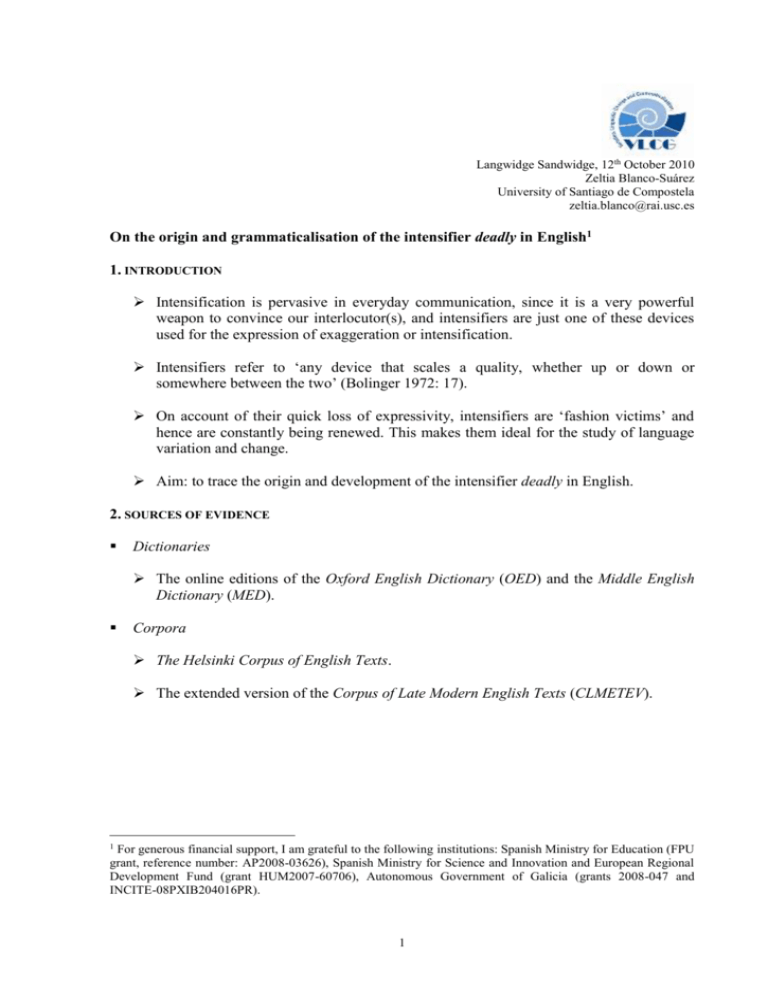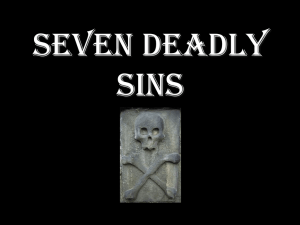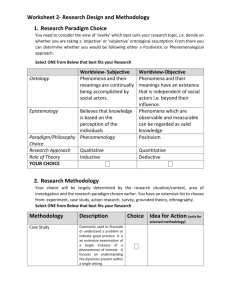Blanco_handout_LS_2010
advertisement

Langwidge Sandwidge, 12th October 2010 Zeltia Blanco-Suárez University of Santiago de Compostela zeltia.blanco@rai.usc.es On the origin and grammaticalisation of the intensifier deadly in English1 1. INTRODUCTION Intensification is pervasive in everyday communication, since it is a very powerful weapon to convince our interlocutor(s), and intensifiers are just one of these devices used for the expression of exaggeration or intensification. Intensifiers refer to ‘any device that scales a quality, whether up or down or somewhere between the two’ (Bolinger 1972: 17). On account of their quick loss of expressivity, intensifiers are ‘fashion victims’ and hence are constantly being renewed. This makes them ideal for the study of language variation and change. Aim: to trace the origin and development of the intensifier deadly in English. 2. SOURCES OF EVIDENCE Dictionaries The online editions of the Oxford English Dictionary (OED) and the Middle English Dictionary (MED). Corpora The Helsinki Corpus of English Texts. The extended version of the Corpus of Late Modern English Texts (CLMETEV). 1 For generous financial support, I am grateful to the following institutions: Spanish Ministry for Education (FPU grant, reference number: AP2008-03626), Spanish Ministry for Science and Innovation and European Regional Development Fund (grant HUM2007-60706), Autonomous Government of Galicia (grants 2008-047 and INCITE-08PXIB204016PR). 1 3. ANALYSIS AND DISCUSSION OF THE DATA 3.1. Evidence from the historical dictionaries In origin, deadly (a. and adv.) was a synonym for ‘fatal(ly), mortal(ly)’: (1) The snakes bite deadly, fatall are their teeth. (1627, OED, s.v. deadly adv. 1). (2) Non of hem had dedeli wounde. (c.1300, MED, s.v. dedli a. 2). Deadly was not limited to the physical domain, but could also denote spiritual death: (3) Þei seye þat wee synne dedly [F mortelement] in schauynge oure berdes.(c. 1425, MED, s.v. dedli adv. 2). At a later stage, deadly gradually developed more subjective or affective meanings, thus applying to qualities typically associated with death (e.g. paleness, darkness, or silence), and could also be used with the meaning ‘to the death’: (4) Kynge Marke wolde nat sende for sir Trystram, for he hated hym dedly. (c. 1470, MED, s.v. dedli adv. 1). These subjective meanings have paved the way for the emergence of intensifying meanings. As an intensifier meaning ‘extreme(ly), excessive(ly)’, deadly (adv.) is not attested until the 14th century, and deadly (a.) is first recorded in 1660: (5) I þat es sa dedli dill. (c. 1300, OED, s.v. deadly adv. 4). (6) A deadly drinker he is, and grown exceedingly fat. (1660, OED, s.v. deadly a. 8a). Thus, deadly fits in the grammaticalisation clines observed in the literature: descriptive adjective > affective adjective > intensifier (Adamson 2000); qualitative adverbs > boosters (Peters 1994); ‘modal-to-intensifier shift’ (Partington 1993). 3.2. Evidence from the corpora The HC 67 tokens of deadly. Clear preponderance of descriptive meanings in the corpus (58 tokens; 86.57%) versus subjective meanings (9 tokens; 13.43%). Substantial reduction of descriptive meanings from OE to eModE (from 100% to 54.54%), and considerable increase of subjective meanings in the same interval (up to 45.45%). 2 Table 1. Distribution of descriptive and subjective meanings of deadly (a. and adv.) in the HC in the different periods. Period OE ME eModE Descriptive meanings Life (2) lichoma ‘body, corpse’ (3), flesh (1), world (1), man (1), list ‘cunning, skill’ (1) Sin (27), life (5), wound (3), flesh (1), man (1), slain (1), case (1), land (1), creature (1), idoruen ‘hurt’ (1), fight (1) Sin (4), weapon (1), wounded (1) Subjective meanings Ifoan ‘enemy’ (1), enemy (1), foe (1), leor ‘countenance’(1) Grief (2), enemy (2), feud (1) OE only registers descriptive meanings: (7) & on ðissum deadlican flæsce he hine selfne æteowde. and on this deadly flesh he him self revealed (OE2. Cura Pastorialis R 52.405.31). ME records both descriptive and subjective meanings, with a significant number of the descriptive collocation deadly sin: (8) Hwa durste slepen hwil his deadliche fa heolde an itohe sweord up on his heaued? who dared sleep while his deadly foe holds a drawn sword up on his head (ME1. Ancrene Wisse P166) (9) For sothe [‘truly’], synne is in two maneres; outher it is venial or deedly synne. (ME3. The Parson’s Tale P298.C1). In eModE both descriptive and subjective meanings can be found. No intensifying meanings have been spotted in the corpus. Deadly (a.) clearly prevails over deadly (adv.), with a record of only three tokens. The CLMETEV 221 tokens of deadly. Wide variety of collocations of deadly in the corpus (sin, poison, peril, paleness, enemy, white, sick, arrow, execration, Nitrous Gas, net, malignity, Gnome, malaria, atom…), which might indicate features of grammaticalised elements, in that it can combine virtually with any word: (10) The fiend Ennui awhile consents to pine, There growls, and curses, like a deadly Gnome, (1812. Rejected Addresses, Cui Bono? I). The vast majority of the occurrences have either neutral or negative connotations, with only 2.71% of the total with positive meanings, albeit the overall meaning of the sentence may be negative: (11) There was a sad, a deadly charm still about the journey. (1920. The Happy Foreigner, ch. XV). 3 Prevalence of subjective meanings of deadly (57.92%) over descriptive meanings (40.27%), and actual presence of intensifying meanings, yet very low (1.80%): (12) He held up the deadly little dagger called the misericorde. (1870. The Caged Lion, ch. II). Deadly is more commonly found as an adjective modifying nouns than as an adverb modifying adjectives/adverbs. 4. CONCLUSIONS The analysis of the data from the corpora and the historical dictionaries has revealed the progressive subjectification and grammaticalisation of deadly over time. In OE only descriptive meanings were found; in ME these are still a majority, but subjective meanings also begin to emerge. Finally, in eModE there is a significant rise in subjective meanings, a process which is at its height in lModE. The paramount importance of religion and wars in medieval society accounts for many of the collocates of deadly, including sin, wound(ed), slain, or weapon. Deadly seems to collocate in the main with items with a negative or neutral meaning, while combinations with positive meanings are rare. Deadly (a.) and deadly (adv.) tally with the usual grammaticalisation clines: descriptive adjective > affective adjective > intensifier and manner adverb > booster. 5. REFERENCES Adamson, S. 2000. A lovely little example. Word order options and category shift in the premodifying string. In O. Fischer, A. Rosenbach, and D. Stein (eds.), Pathways of Change. Grammaticalization in English, 39-66. Amsterdam and Philadelphia: John Benjamins. Bolinger, D. 1972. Degree Words. The Hague and Paris: Mouton. MED = Kurath, H. et al. (eds.). 1952-2001. Middle English Dictionary. Ann Arbor, MI: University of Michigan Press. Online version. Available at: http://quod.lib.umich.edu/m/med/. OED. Oxford English Dictionary. 1989. (2nd ed.). Oxford: Oxford University Press. Online version with revisions. Available at: http://www.oed.com. Partington, A. 1993. Corpus evidence of language change. The case of the intensifier. In M. Baker, G. Francis, and E. Tognini-Bonelli (eds.), Text and Technology. In Honour of John Sinclair, 177-192. Amsterdam and Philadelphia: John Benjamins. Peters, H. 1994. Degree adverbs in Early Modern English. In D. Kastovsky (ed.), Studies in Early Modern English, 269-288. Berlin: Mouton de Gruyter. 6. SOURCES CLMETEV = Corpus of Late Modern English Texts Extended Version. 2006. Leuven: Department of Linguistics. HC = The Helsinki Corpus of English Texts. 1991. Helsinki: Department of English. 4







